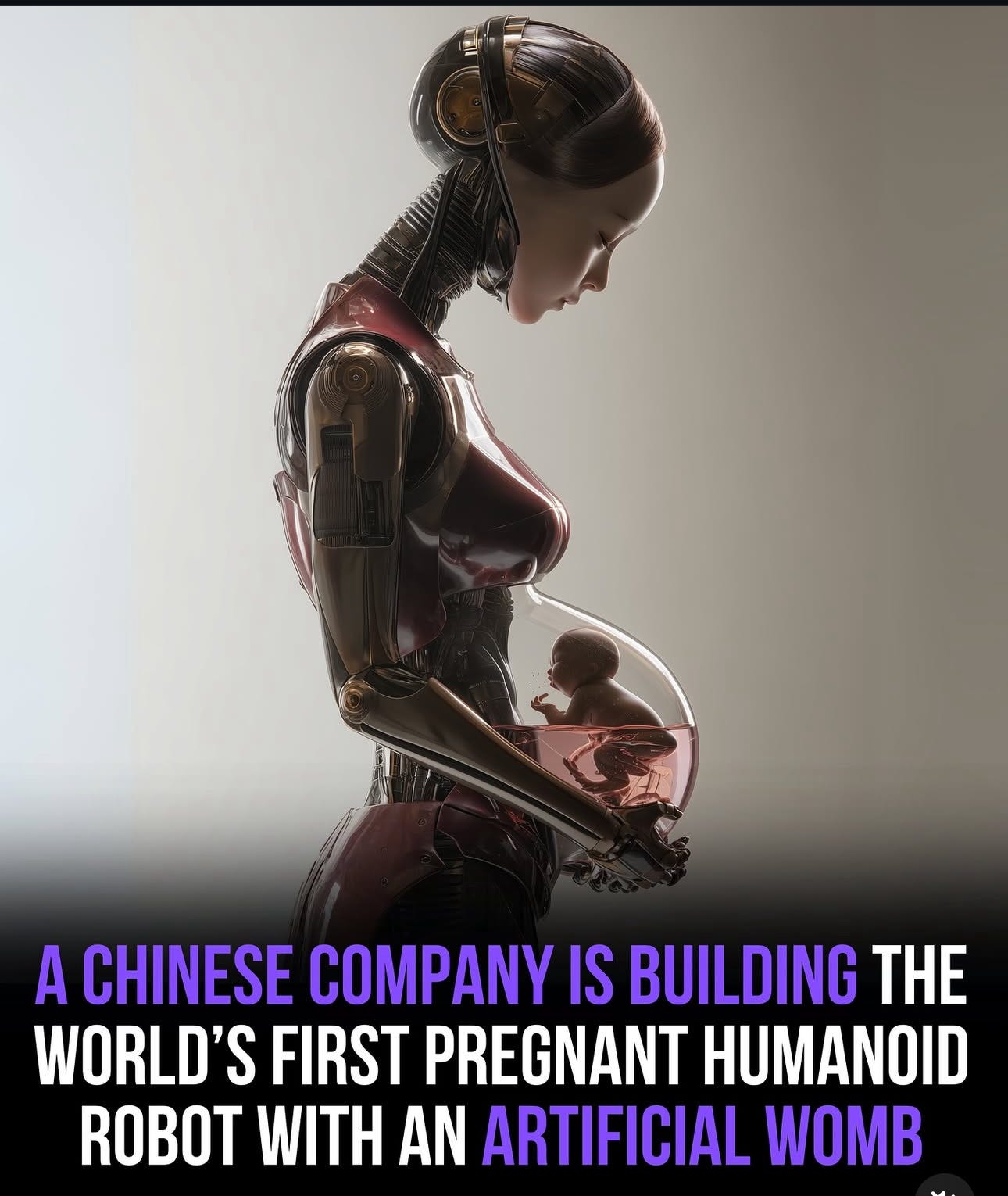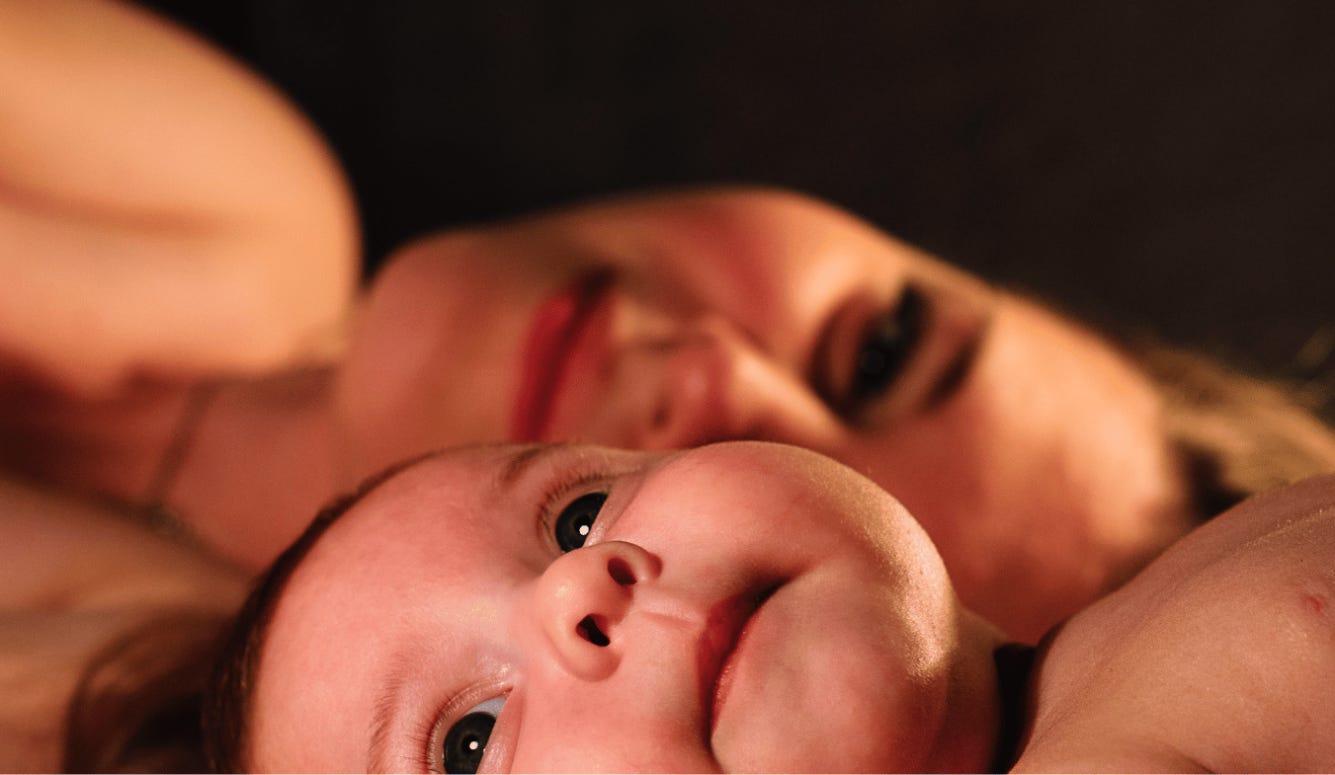Humanoid birth machine
Plans for AI to breed the future.
Disclaimer
I personally do not advocate any process or procedure contained in any of my Blogs. Information presented here is not intended to provide legal or lawful advice, nor medical advice, diagnosis, treatment, cure, or prevent any disease. Views expressed are for educational purposes only.
I surround, protect, purify and make harmless the following in-formation.
Coherent Reality
Jan Wellmann
Aug 17.25
A Chinese startup, Kaiwa Technology, claims it’s building a “pregnancy humanoid robot” with an artificial womb, slated to debut around 2026 for under ¥100,000 (~$14k).
It sounds like an absurd joke—until you notice the vertiginous drop in global fertility, traceable to manmade causes, most of which are anything but accidental.
https://substack.com/@janwellmann/note/c-146300417
Aug 15, 2025
A Chinese tech firm is racing to deliver what could be the world’s first “gestation robot”. The idea from Kaiwa Technology, based in Guangzhou, involves a humanoid designed with an artificial womb embedded in its abdomen, intended to carry a fetus through ten months of gestation and deliver a baby, according to Chinese media outlets.
Slated for debut by 2026 and expected to sell for under 100,000 yuan (around $13,900), the robot aims to offer a pregnancy alternative for those who wish to avoid the burdens of human gestation.
Humanoid birth machine
The bold vision of a humanoid surrogate pregnancy robot was presented at the 2025 World Robot Conference in Beijing by Zhang Qifeng, founder of Kaiwa Technology and affiliated with Nanyang Technological University, according to ECNS.
According to Qifeng, it is not merely an incubator but a life-sized humanoid equipped with an artificial womb in its abdomen, capable of replicating the entire process from conception to delivery.
The core innovation lies in artificial womb technology, where a fetus develops in artificial amniotic fluid and receives nutrients through a hose, mimicking natural gestation. Dr. Zhang claimed the technology is already mature in laboratory settings and now needs integration into a humanoid form to enable real human–robot interaction during pregnancy, according to Oddity Central.
Current artificial wombs function more like neonatal incubators, supporting life only after partial gestation. For Dr. Zhang’s concept to work, the technology must advance to support fertilization, implantation, and full-term pregnancy—details he did not disclose, leaving questions about the scientific, ethical, and legal challenges ahead.
Another notable development showcased at the 2025 World Robot Conference is the world’s first AI-powered breeding robot—integrating artificial intelligence and biotechnology to revolutionize crop breeding.
9 Humanoid Robots Shaping the Future of Work
Jun 11, 2024
Humanoid robots have been a longstanding trope of science fiction. Only recently have they become a varied market of real alternatives. Different humanoid robots are best suited to different tasks. The Digit from Agility has already been deployed in Amazon warehouses, While Boston Dynamics' new Atlas robot is more multifunctional.
The GR-1 from Fourier Intelligence has therapeutic and healthcare uses. While the Tesla Optimus looks like it could be deployed in law enforcement. There will soon be a humanoid robot for every scenario. The question is whether humanity is ready for them.
Live links and more at https://interestingengineering.com/innovation/china-worlds-first-pregnancy-humanoid-robot
‘Significant’ Fertility Drop Linked to COVID-19 Injection, Czech Study Finds
May 01, 2025
First study to assess real-world fertility outcomes at a national level in relation to COVID-19 injections.
UPDATE: On June 19, 2025, the study was published in the peer-reviewed journal International Journal of Risk & Safety in Medicine with minor amendments.
The study, led by Vibeke Manniche and colleagues, used anonymised summary data from the Institute of Health Information and Statistics of the Czech Republic (IHIS) alongside COVID-19 injection records. It excluded women who received the injection during pregnancy to isolate the impact of pre-conception injections.
Researchers calculated monthly conception rates per 1,000 women for both groups and found the gap to be consistent and statistically noteworthy across the dataset.
The injections administered were predominantly mRNA-based, with Pfizer-BioNTech’s Comirnaty and Moderna’s Spikevax making up 96% of doses. The study is one of the first to assess real-world fertility outcomes at a national level in relation to COVID-19 injections.
While the study’s findings suggest a significant association, the authors have cautioned against drawing definitive conclusions about causality.
They note that unmeasured factors — such as differences in contraceptive use, socioeconomic status, health conditions, or personal decisions about pregnancy — may have contributed. For example, some women might have chosen to delay conception until after injection or may have avoided the injection due to fertility concerns.
Still, the authors argue that such behavioural factors alone cannot fully explain the data, particularly since the national birth rate also declined during this period — from 1.83 births per 1,000 women in 2021 to 1.45 in 2023.
The study also highlights a possible “batch-dependent safety signal” with certain product batches, a pattern reportedly observed in Denmark, Sweden, and the United States.
Concerns about fertility have been a key source of global hesitancy regarding the COVID-19 injections. Although previous studies and health authorities have generally labelled the products safe for pregnant women, menstrual irregularities and ovarian effects have been documented in some scientific literature.
Continues at https://dailydeclaration.org.au/2025/05/01/covid-19-czech-fertility/
Miracle of life
Is portraying human gestation as a burden deliberately misleading, to strengthen dark agendas that serve few at the expense of many?
As a human mother, I experienced one of life’s most cherished miracles through giving birth.
Falling Fertility: A Crisis We Refuse to Face
In the end, children are the only reliable means we have of projecting human life, human consciousness, and human potential into the future. No machine, institution, or archive can do that.
If we fail to make it not only possible but desirable to bear and rear children, we risk more than skewed labour ratios and bankrupt social security schemes. We risk a downward spiral for humanity from which we may never emerge.
https://quillette.com/2025/06/13/falling-fertility-a-crisis-we-refuse-to-face-demographics/
Without prejudice and without recourse
Doreen Agostino
Our Greater Destiny Blog
ai



We need to relearn how to see children not as burdens to be offset, but as bearers of continuity, care, and cultural inheritance.
Science is always doing things that the people don't want. Where is the cure for so many diseases and where are the solutions to growing food without poisons? I guess they're not paying for it, the people are, so why not just delve into these areas that only gratify them?